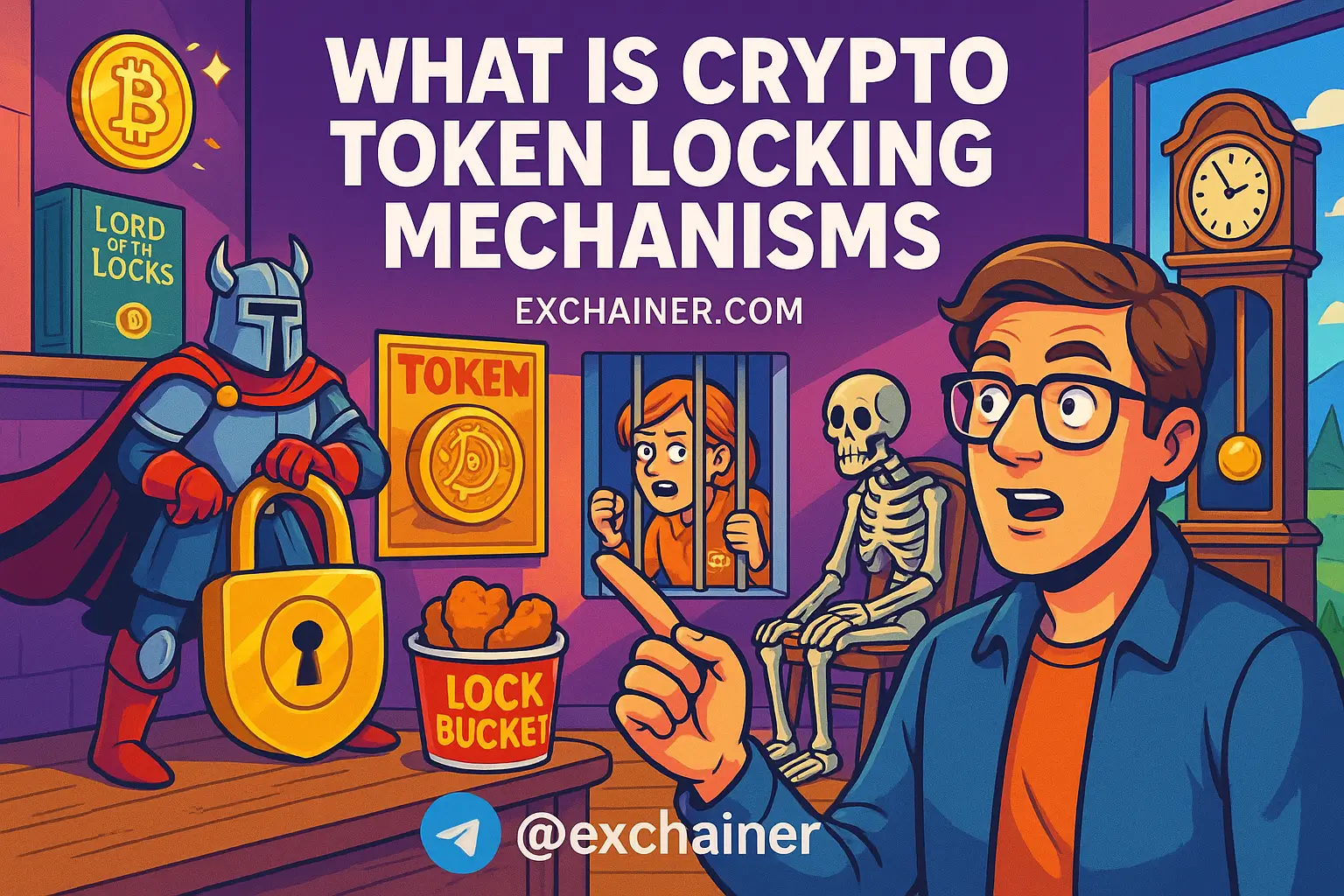Imagine this: a buzz is building around a shiny new crypto project launching its token. The community is excited, eager to invest, but there’s that nagging worry about “rug pulls” — when developers vanish with investors’ funds, leaving everyone high and dry. So, how can investors feel confident that their holdings won’t evaporate overnight? Enter crypto token locking mechanisms – a critical toolbox that projects use to secure tokens, ensure fairness, and build trust.
Crypto token locking mechanisms refer to methods implemented mostly through smart contracts that restrict the transfer, sale, or use of tokens for certain periods or under specific conditions. They include vesting schedules, time-lock smart contracts, and liquidity locks—each playing a distinct role in project governance and investor protection. These techniques not only help curb sudden dumps that can crash token prices but also strengthen the credibility of projects, appealing to regulatory frameworks and community governance models alike.
This guide is tailored for a broad audience: founders designing tokenomics, investors scouting safer projects, auditors assessing smart contracts, and token economists analyzing distribution impacts. Throughout this article, you will uncover the workings of token vesting, the mechanics behind time-locked contracts, how liquidity locks prevent rug pulls, and key security considerations to watch out for. By the end, you’ll have practical insights and checklists that empower you to evaluate tokens confidently and contribute to healthier crypto ecosystems.
Token Vesting Explained
One of the foundational types of crypto token locking mechanisms is token vesting. Essentially, token vesting means tokens allocated to team members, advisors, or early investors become gradually accessible according to a predefined schedule, rather than all at once. This mechanism is vital to align incentives, ensuring that project insiders stay committed long-term rather than making quick profits by dumping tokens immediately.
Vesting schedule types
There are several common vesting schedules utilized in the crypto space:
Cliff vesting – Tokens remain completely locked until a certain ‘cliff’ time passes, after which a lump sum is released to the beneficiary. For example, a 1-year cliff means no tokens release before one year, with all or a portion available after.
Linear vesting – Tokens gradually unlock evenly over time, such as monthly or quarterly releases spread over several years. This smoothes token distribution and limits sudden market shocks.
Graded (or step-wise) vesting – Tokens are released in chunks at set intervals, like 25% every six months, which balances between cliff and linear approaches.
Each schedule caters to different participants: team members might receive linear vesting to stay engaged, advisors often get cliff schedules aligned with milestones, while seed investors may have hybrid setups.
Purpose and incentives
Vesting aligns incentives by motivating contributors to stick with the project, directly supporting long-term token value. Without vesting, insiders might sell tokens quickly to cash out, causing “sell pressure” that undermines price stability and shakes investor confidence. Proper vesting frameworks reduce market volatility and foster a sense of fairness, crucial for sustaining community trust and project health.
Implementation patterns
Technically, token vesting leverages smart contracts that automate token release per the schedule. Simple contracts just release tokens linearly or at cliff milestones. More advanced designs include revocable vesting, where tokens can be clawed back if certain conditions aren’t met—although this requires trust and transparency.
Most vesting contracts follow standards like ERC-20 or ERC-1400 for Ethereum tokens, with parameters such as start date, cliff duration, total vesting length, and beneficiary address encoded clearly. Open-source libraries, including those from OpenZeppelin, offer reusable vesting modules that are widely audited and trusted by developers.
Time-Lock Smart Contracts
Another core element in crypto token locking mechanisms is time-locked smart contracts. These contracts restrict token or action execution until a specific time or blockchain condition is met, providing an on-chain guarantee that certain operations won’t happen prematurely.
Core mechanics and primitives
At their core, time-lock contracts depend on checking blockchain timestamps or block numbers to enforce release schedules. For example, a contract may check if the current block timestamp is past a set date before allowing token transfers or contract function calls. Some systems also use explicit off-chain triggers connected by oracles but on-chain time-locks are the most transparent and trustless.
Common timelock patterns and libraries
Popular timelock implementations include OpenZeppelin’s TimelockController, which schedules governance actions to execute after delay periods, giving token-holders time to review and react. Combine this with multisig wallets—in which multiple parties must sign off on actions—and you get powerful security layers that mitigate insider risks.
Governance protocols often use these time-locks for executing approved proposals, introducing transparency and safeguards that keep projects accountable to their communities.
Design considerations and gotchas
Building robust time-lock mechanisms requires awareness of common pitfalls. For example, blockchain reorganization events (“reorgs”) can lead to timestamp inconsistencies, so contracts should avoid relying solely on block timestamps for critical logic. Also, deciding between immutable (cannot change once deployed) versus upgradeable timelocks affects flexibility versus security trade-offs.
Liquidity Locks & Presale Safety
Liquidity locks represent an indispensable defense in the arsenal of crypto token locking mechanisms, especially crucial during presales and initial dex offerings (IDOs). By locking liquidity provider (LP) tokens, projects ensure the underlying liquidity pool can’t be withdrawn instantly, greatly reducing the risk of rug pulls.
What liquidity locking is and why it matters
When a token is launched on decentralized exchanges (DEXs) like Uniswap or PancakeSwap, liquidity providers supply pairs of tokens creating trading pools. Locking these LP tokens means they cannot be withdrawn or sold for a predefined period, securing the pool’s integrity. Unlike native token locks, liquidity locks directly safeguard market depth, assure investors there’s ‘real’ liquidity, and help stabilize prices.
Platforms and tooling for liquidity locks
Several platforms specialize in liquidity locking services and tooling, such as Unicrypt and Team.Finance. These services allow projects to deposit LP tokens into smart contracts, locking them for specified durations. There are trustless lockers, fully on-chain, and centralized custodial lockers, each with pros and cons relating to security and transparency.
Metrics and verification for presales
As an investor, verifying liquidity locks is essential. You can check the token contract’s events to confirm LP token deposits and lock durations. Audited lockers publish their smart contract code and security reports, which you should review for assurance. Red flags include unverified lockers, very short lock periods, and contracts without upgrade or withdrawal restrictions.
Security Risks, Audits & Best Practices
Despite the safeguards token locking mechanisms provide, poorly implemented locks can introduce vulnerabilities. Understanding these risks and how to mitigate them is crucial for both developers and investors.
Common vulnerabilities in lock implementations
Typical problems include reentrancy attacks—where an attacker exploits a function call loop to drain tokens—owner backdoors that allow premature unlocking, improper checks on time values, and revocable locks without transparency. Improper access controls may enable unauthorized parties to modify lock terms or withdraw tokens early.
Audit checklist for token locks
Auditors rigorously examine the contract logic, particularly focusing on the enforcement of time constraints, ownership management, upgradeable proxies, and multisig wallet integrations. They test for edge cases like chain reorganizations or unexpected inputs and often employ formal verification where feasible to mathematically prove correctness.
Mitigations and operational best practices
Projects should employ transparent multisig wallets, publicly documented lock parameters, and prefer third-party trusted lockers over personal custody. Conservative lock durations, community involvement, and regular audits further minimize risks. For investors, engaging with tokens that adhere to these practices signals higher project reliability.
Conclusion
In the dynamic world of digital currency, crypto token locking mechanisms are essential pillars of trust and governance. From token vesting schedules that align incentives and reduce sell pressure, to time-lock smart contracts that safeguard governance actions, and liquidity locks that protect against rug pulls, each plays a vital role in creating resilient crypto projects. Knowing how these mechanisms work equips founders with frameworks for responsible tokenomics and empowers investors to identify safer opportunities.
Before investing, always check on-chain lock contracts, verify liquidity pools’ lock statuses, and review audit reports carefully. For projects, deciding when to use vesting rather than immediate token releases, selecting appropriate timelock patterns, and employing reputable liquidity lockers are strategic decisions shaping long-term success. As the ecosystem matures, expect evolving standards and innovations that balance flexibility with enhanced trust.
If you’re eager to deepen your understanding and stay updated on practical crypto trading, governance, and security tactics, be sure to explore more insightful articles and reviews designed just for you.
Feel free to check out our extensive educational resources at Crypto 101, read detailed platform analyses at Exchange Reviews, and find the best wallets and tools at Tools and Wallets.
Also, for authoritative external information, consider visiting CoinMarketCap’s glossary on vesting, and explore official documentation of popular lockers like Unicrypt Docs.












